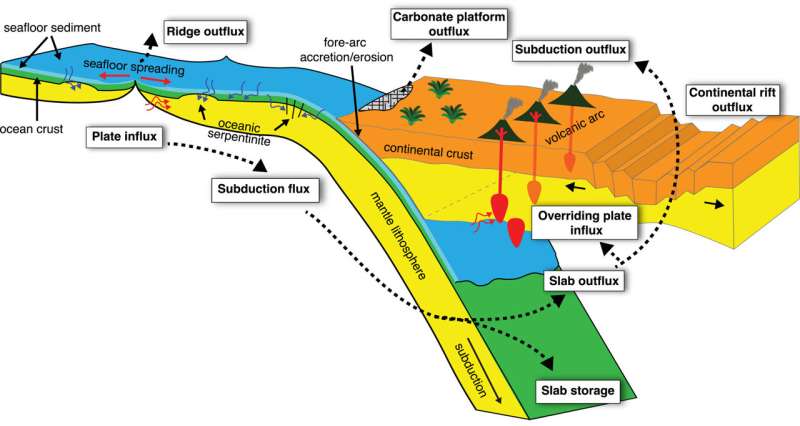
November 7, 2024 by Saima May Sidik, Eos
Collected at: https://phys.org/news/2024-11-advances-plate-tectonics-view-deep.html
From time to time, when Earth’s tectonic plates shift, the planet emits a long, slow belch of carbon dioxide. In a new modeling study published in Geochemistry, Geophysics, Geosystems, R. Dietmar Müller and colleagues show how this gas released from deep Earth may have affected the climate over the past billion years.
Volcanoes, undersea vents, and mid-ocean ridges are all found where Earth’s plates collide or separate. Each of these structures gives carbon dioxide a route to escape from the depths of the planet and enter the atmosphere. Although their impact on the climate is minor compared to anthropogenic emissions, gases released from deep Earth are thought to have a substantial impact on the composition of Earth’s atmosphere over geologic timescales.
Scientists have often estimated the volume of such carbon emissions solely on the basis of the gas released by plate tectonics. But plate tectonics can also capture carbon by incorporating it into new crust formed at mid-ocean ridges. In the new work, researchers drew on two recent studies about the past billion years of plate movement to more precisely model how much carbon dioxide this process has generated.
The model’s findings are consistent with how Earth’s climate is thought to have changed over time. For example, the periods during which the model suggests more carbon was being released line up with warmer periods of Earth’s history, such as the start of the Ediacaran period about 653 million years ago.
Periods that the model suggests may have had lower levels of carbon outgassing coincide with colder periods of Earth’s history, such as the “snowball Earth” period from 700 million to 600 million years ago.
The research also suggests that Pangea’s breakup allowed large amounts of carbon dioxide to be released as the planet’s plates moved apart, which is consistent with the warming that’s thought to have occurred during that time.
Tectonic activity is a major determinant of Earth’s atmospheric composition over geologic time, the researchers conclude. Despite recent advances, much remains to be learned about how plate movement affects the planet’s carbon cycle.
More information: R. Dietmar Müller et al, Solid Earth Carbon Degassing and Sequestration Since 1 Billion Years Ago, Geochemistry, Geophysics, Geosystems (2024). DOI: 10.1029/2024GC011713
Journal information: Geochemistry, Geophysics, Geosystems

Leave a Reply